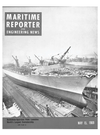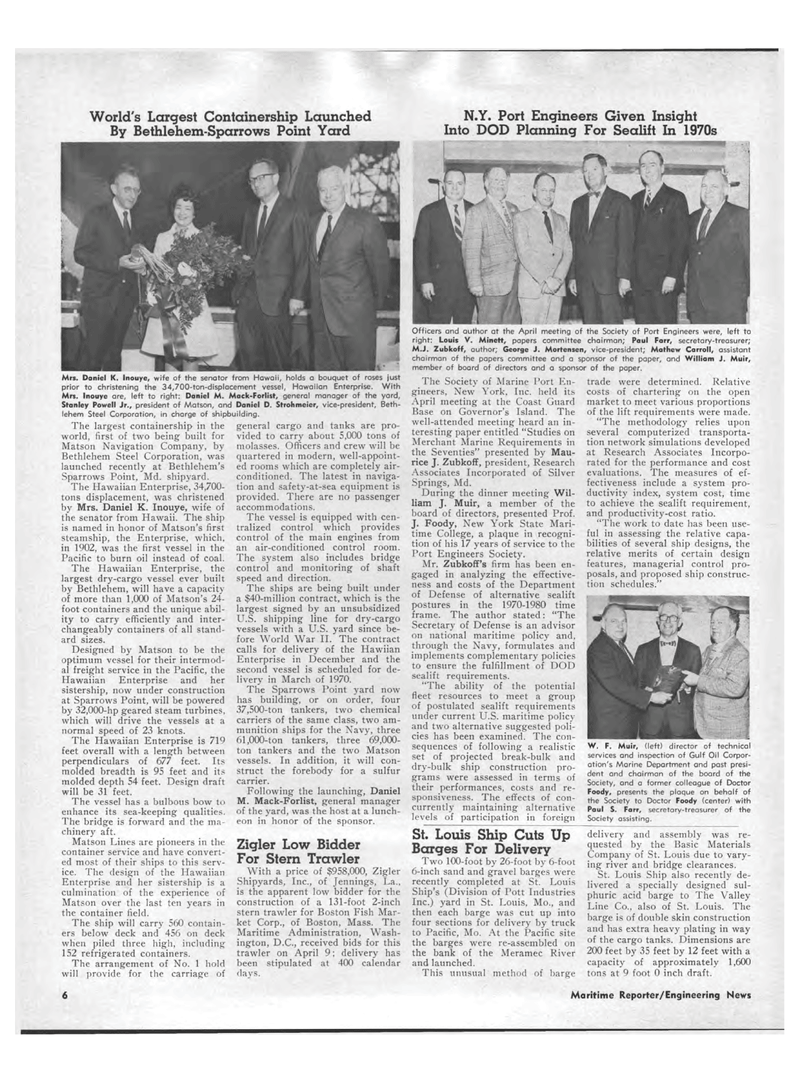
Page 4: of Maritime Reporter Magazine (May 15, 1969)
Read this page in Pdf, Flash or Html5 edition of May 15, 1969 Maritime Reporter Magazine
World's Largest Containership Launched By Bethlehem-Sparrows Point Yard Mrs. Daniel K. Inouye, wife of the senator from Hawaii, holds a bouquet of roses just prior to christening the 34,700-ton-displacement vessel, Hawaiian Enterprise. With Mrs. Inouye are, left to right: Daniel M. Mack-Forlist, general manager of the yard, Stanley Powell Jr., president of Matson, and Daniel D. Strohmeier, vice-president, Beth-lehem Steel Corporation, in charge of shipbuilding. The largest containership in the general cargo and tanks are pro-world, first of two being built for Matson Navigation Company, by Bethlehem Steel Corporation, was launched recently at Bethlehem's Sparrows Point, Md. shipyard. The Hawaiian Enterprise, 34,700-tons displacement, was christened by Mrs. Daniel K. Inouye, wife of the senator from Hawaii. The ship is named in honor of Matson's first steamship, the Enterprise, which, in 1902, was the first vessel in the Pacific to burn oil instead of coal. The Hawaiian Enterprise, the largest dry-cargo vessel ever built by Bethlehem, will have a capacity of more than 1,000 of Matson's 24-foot containers and the unique abil-ity to carry efficiently and inter-changeably containers of all stand-ard sizes. Designed by Matson to be the optimum vessel for their intermod-al freight service in the Pacific, the Hawaiian Enterprise and her sistership, now under construction at Sparrows Point, will be powered by 32,000-hp geared steam turbines, which will drive the vessels at a normal speed of 23 knots. The Hawaiian Enterprise is 719 feet overall with a length between perpendiculars of 677 feet. Its molded breadth is 95 feet and its molded depth 54 feet. Design draft will be 31 feet. The vessel has a bulbous bow to enhance its sea-keeping qualities. The bridge is forward and the ma-chinery aft. Matson Lines are pioneers in the container service and have convert-ed most of their ships to this serv-ice. The design of the Hawaiian Enterprise and her sistership is a culmination of the experience of Matson over the last ten years in the container field. The ship will carry 560 contain-ers below deck and 456 on deck when piled three high, including 152 refrigerated containers. The arrangement of No. 1 hold will provide for the carriage of vided to carry about 5,000 tons of molasses. Officers and crew will be quartered in modern, well-appoint-ed rooms which are completely air-conditioned. The latest in naviga-tion and safety-at-sea equipment is provided. There are no passenger accommodations. The vessel is equipped with cen-tralized control which provides control of the main engines from an air-conditioned control room. The system also includes bridge control and monitoring of shaft speed and direction. The ships are being built under a $40-million contract, which is the largest signed by an unsubsidized U.S. shipping line for dry-cargo vessels with a U.S. yard since be-fore World War II. The contract calls for delivery of the Hawiian Enterprise in December and the second vessel is scheduled for de-livery in March of 1970. The Sparrows Point yard now has building, or on order, four 37,500-ton tankers, two chemical carriers of the same class, two am-munition ships for the Navy, three 61,000-ton tankers, three 69,000-ton tankers and the two Matson vessels. In addition, it will con-struct the forebody for a sulfur carrier. Following the launching, Daniel M. Mack-Forlist, general manager of the yard, was the host at a lunch-eon in honor of the sponsor. Zigler Low Bidder For Stern Trawler With a price of $958,000, Zigler Shipyards, Inc., of Jennings, La., is the apparent low bidder for the construction of a 131-foot 2-inch stern trawler for Boston Fish Mar-ket Corp., of Boston, Mass. The Maritime Administration, Wash-ington, D.C., received bids for this trawler on April 9; delivery has been stipulated at 400 calendar davs. St. Louis Ship Cuts Up Barges For Delivery Two 100-foot by 26-foot by 6-foot 6-inch sand and gravel barges were recently completed at St. Louis Ship's (Division of Pott Industries Inc.) yard in St. Louis, Mo., and then each barge was cut up into four sections for delivery by truck to Pacific, Mo. At the Pacific site the barges were re-assembled on the bank of the Meramec River and launched. This unusual method of barge delivery and assembly was re-quested by the Basic Materials Company of St. Louis due to vary-ing river and bridge clearances. St. Louis Ship also recently de-livered a specially designed sul-phuric acid barge to The Valley Line Co., also of St. Louis. The barge is of double skin construction and has extra heavy plating in way of the cargo tanks. Dimensions are 200 feet by 35 feet by 12 feet with a capacity of approximately 1,600 tons at 9 foot 0 inch draft. N.Y. Port Engineers Given Insight Into DOD Planning For Sealift In 1970s Officers and author at the April meeting of the Society of Port Engineers were, left to right: Louis V. Minett, papers committee chairman; Paul Farr, secretary-treasurer; M.J. Zubkoff, author; George J. Mortensen, vice-president; Mathew Carroll, assistant chairman of the papers committee and a sponsor of the paper, and William J. Muir, member of board of directors and a sponsor of the paper. The Society of Marine Port En-gineers, New York. Inc. held its April meeting at the Coast Guard Base on Governor's Island. The well-attended meeting heard an in-teresting paper entitled "Studies on Merchant Marine Requirements in the Seventies" presented by Mau-rice J. Zubkoff, president, Research Associates Incorporated of Silver Springs, Md. During the dinner meeting Wil-liam J. Muir, a member of the board of directors, presented Prof. J. Foody, New York State Mari-time College, a plaque in recogni-tion of his 17 years of service to the Port Engineers Society. Mr. Zubkoff's firm has been en-gaged in analyzing the effective-ness and costs of the Department of Defense of alternative sealift postures in the 1970-1980 time frame. The author stated: "The Secretary of Defense is an advisor on national maritime policy and, through the Navy, formulates and implements complementary policies to ensure the fulfillment of DOD sealift requirements. "The ability of the potential fleet resources to meet a group of postulated sealift requirements under current U.S. maritime policy and two alternative suggested poli-cies has been examined. The con-sequences of following a realistic set of projected break-bulk and dry-bulk ship construction pro-grams were assessed in terms of their performances, costs and re-sponsiveness. The effects of con-currently maintaining alternative levels of participation in foreign trade were determined. Relative costs of chartering on the open market to meet various proportions of the lift requirements were made. "The methodology relies upon several computerized transporta-tion network simulations developed at Research Associates Incorpo-rated for the performance and cost evaluations. The measures of ef-fectiveness include a system pro-ductivity index, system cost, time to achieve the sealift requirement, and productivity-cost ratio. "The work to date has been use-ful in assessing the relative capa-bilities of several ship designs, the relative merits of certain design features, managerial control pro-posals, and proposed ship construc-tion schedules." W. F. Muir, (left) director of technical services and inspection of Gulf Oil Corpor-ation's Marine Department and past presi-dent and chairman of the board of the Society, and a former colleague of Doctor Foody, presents the plaque on behalf of the Society to Doctor Foody (center) with Paul S. Farr, secretary-treasurer of the Society assisting. 6 Maritime Reporter/Engineering News

 3
3

 5
5
